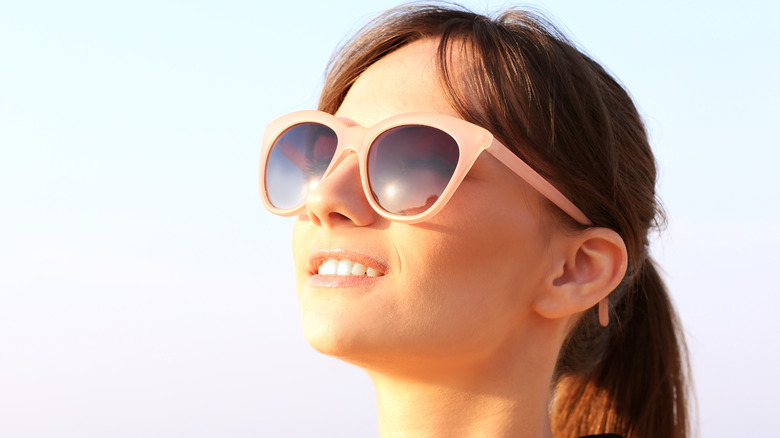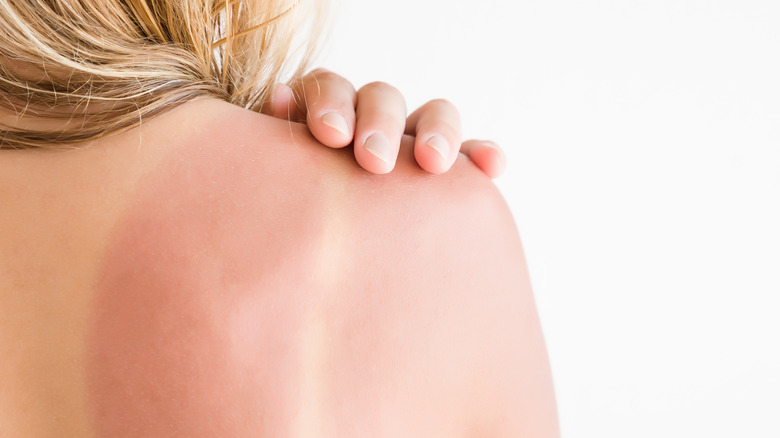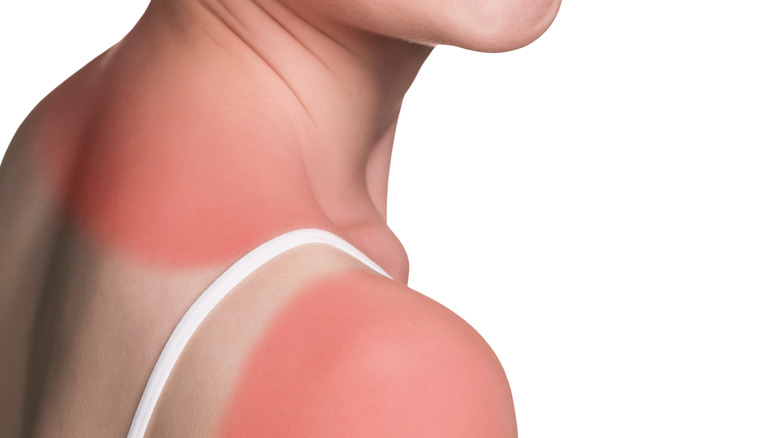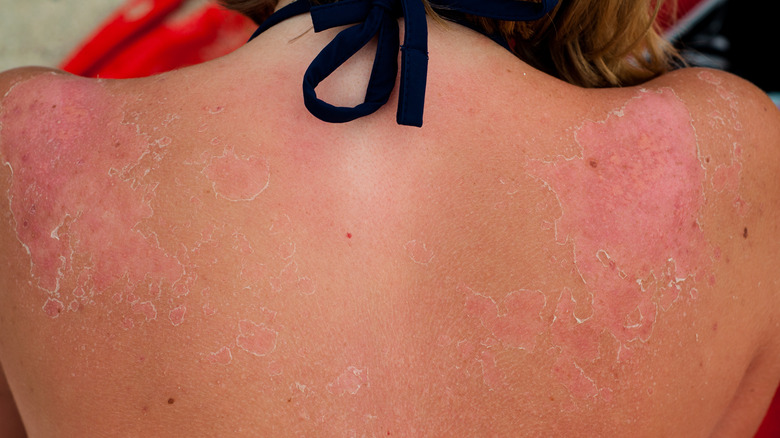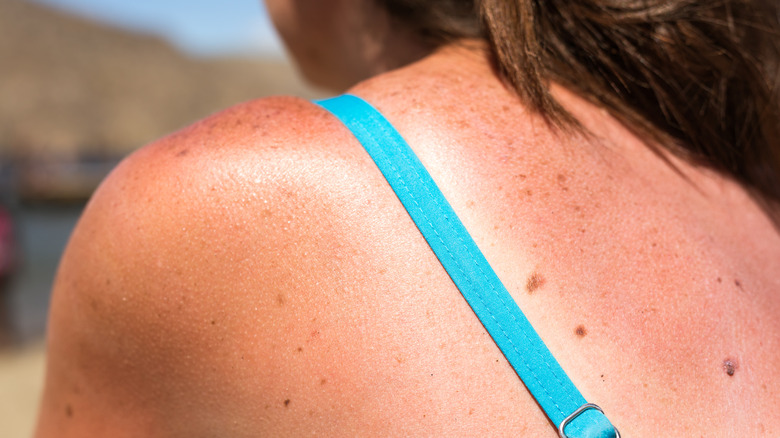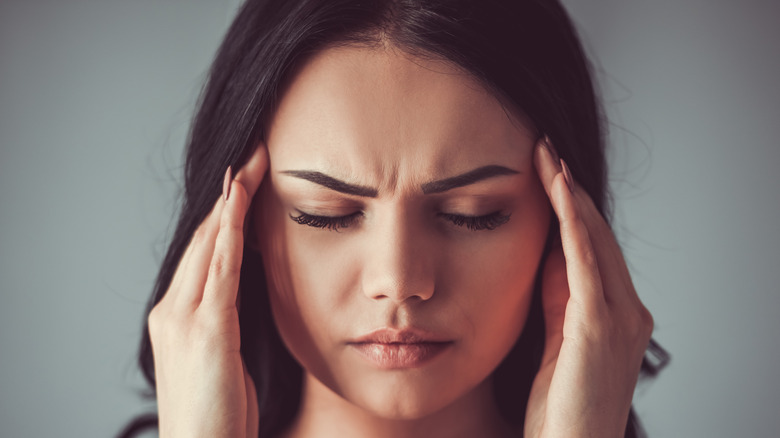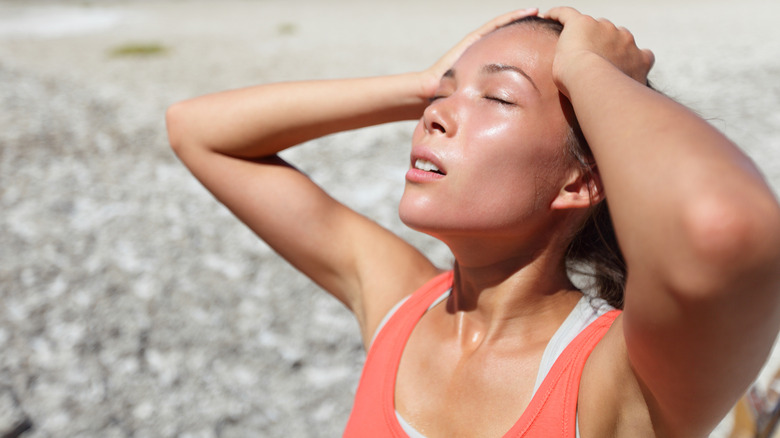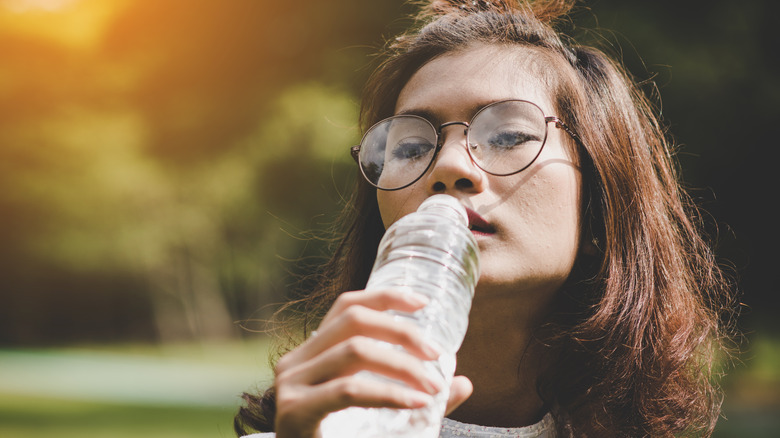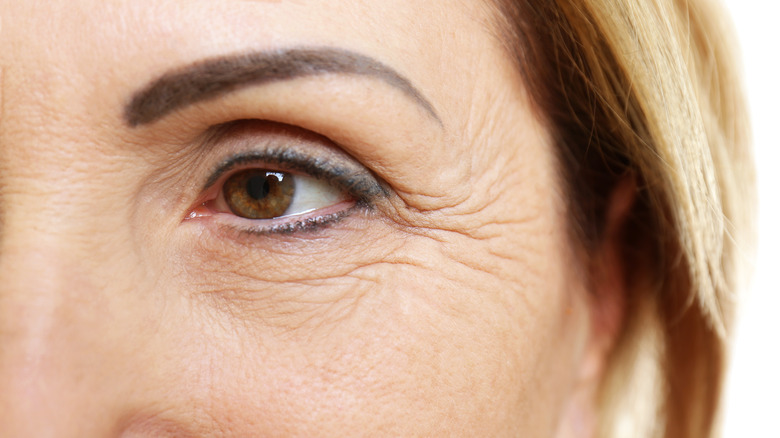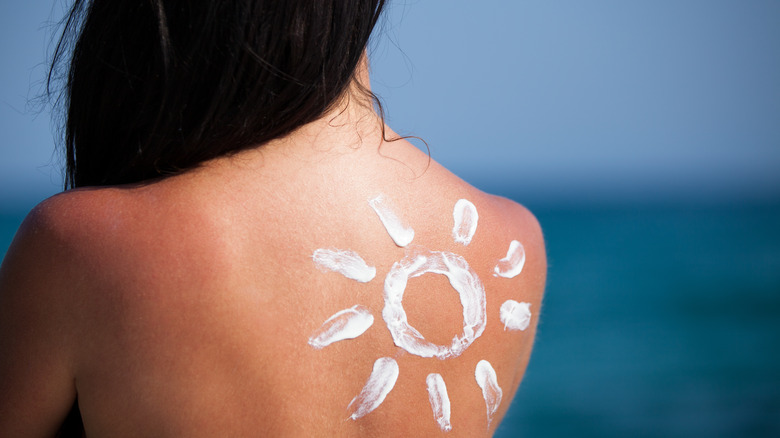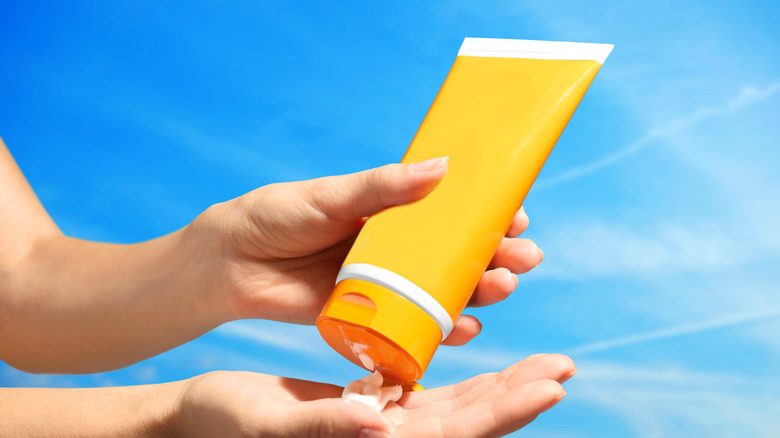Signs You're Getting Too Much Sun
Who doesn't enjoy a beautiful day in the sun? Whether you're at the beach, enjoying a jog, or with friends and family at a backyard barbecue, sunshine and warm weather tend to make us happy. According to a study published by Harvard Medical School, there are many benefits of the sun including increasing your levels of vitamin D, reversing Seasonal Affective Disorder (SAD), and generally elevating your mood. But is it possible to have too much of a good thing? Absolutely.
Overexposure to the sun can wreak havoc on your skin and potentially make you very ill. But that doesn't mean you need to stay inside, it just means you need to know the signs of when you've had too many rays. I asked several medical experts to weigh in and explain how we can best enjoy the sun while still staying safe and healthy.
You burn
From the time we were little kids, sunburns have always felt like an annoying threat. Our mothers warned us that if we didn't listen to her and wear our sunscreen that we would end up getting burned. But what exactly is a sunburn? I asked renowned dermatologist Dr. Gary Goldenberg of Goldenberg Dermatology in New York City to define it for me. He said, "A sunburn is sun/UV related skin damage in a high dose over a short period of time."
The telltale signs of a sunburn are redness and swelling. Dr. Goldenberg added, "These changes are related to the amount and depth of damage of keratinocytes." While a sunburn might just feel like a temporary inconvenience, they can end up being truly more than just unpleasant.
Your skin turns red
Even if you don't feel like you've been burned, a sure sign you have a sunburn is that your skin turns red. Dr. Neal Schultz, who is a host of DermTV told Huffington Post that redness is a sign of inflammation and can be the result of dead skin cells. Have you ever had a sunburn that was so severe your skin started to peel? Peeling is really just those dead cells sloughing off.
According to Dr. Sal Nadkarni, who is an internist in Los Angeles, redness and burns don't just occur during the summer after too many hours at the beach or by the pool. He explained, "Sand, water, and even snow can intensify the sun's rays." So, don't forget to pack your sunscreen during your next ski vacation.
You blister
One major sign you've had too much sun is that your skin blisters. A reaction like this must be taken very seriously. Dr. Goldenberg explained that skin blistering is the most severe type of sunburn.
"[Blistering] relates to complete damage of the epidermis by UV [rays]. When these cells are damaged, their DNA is damaged." This can be incredibly dangerous and potentially irreversible.
These blisters can even affect us for the rest our lives. Dr. Goldenberg added, "This DNA damage may not ever be completely repaired and can lead to skin cancer. In fact, a single blistering sunburn before the age of 18 has been shown to increase the risk of developing a melanoma [a type of skin cancer] over a lifetime."
You develop sun poisoning
Sun poisoning is one of those problems that sounds far more terrifying than it actually is, but it should still be taken seriously. There's a difference between sunburn and sun poisoning, and it has to do with just how severely you've been burned. Dr. Nadkarni broke it down for me, saying, "Sun poisoning doesn't mean that you were actually poisoned. It just refers to getting exposed to excessive sun causing severe sunburn from damaging UV rays."
But, sun poisoning can still be harmful. Now, what exactly happens to your body when you get sun poisoning? "Severe sunburn or sun poisoning causes symptoms such as nausea, swelling, blistering, dehydration, fevers, dizziness, and headaches," Nadkarni explained.
Dr. Nadkarni suggests if you start to exhibit any of these symptoms, the best thing to do is go indoors. "Get out of the sun as soon as possible, and either take a cold shower or apply cold compresses to the affected area. You should also immediately apply aloe lotion or moisturizer to soothe the affected areas. Take Tylenol or Advil for any pain or fevers. And drink plenty of water for several days afterwards."
You get a headache
One dangerous sign you've had too much sun is getting a headache and it doesn't just happen if you have sun poisoning. According to the Miami Headache Institute, the brightness from the sun can trigger headaches or, even worse, for some people it can cause migraines. This is due to light sensitivity and contrast that occurs when you look at something very dark and then something very light and vice versa. They suggest wearing sunglasses and avoiding looking into the sun directly.
Dr. Nadkarni also suggests if your headache gets really bad, you might need to see a doctor immediately because it could be a sign of something worse. "If you get a severe headache and experience confusion, faintness, or dizziness, you should seek immediate medical attention, as these are signs of severe dehydration or possibly even heat exhaustion/heat stroke."
He added it's always best to wear polarized lenses to protect your eyes. You can find sunglasses with polarized lenses at most optical stores.
You aren't sweating even though it's hot
Most of the time when you go out in the sun, you anticipate that you are going to work up a sweat. But if the temperature is high and you are not sweating, it could be a sign of a dangerous condition. According to Nurse Nataly of iGlow Med Spa in Beverly Hills, California, "One of the first signs of too much sun is that you will begin to sweat. If you feel as if you sweltering in the summer heat and you suddenly stop, it means that [you] are overheating."
Nurse Nataly said this, like a bad headache, could be the sign of a heat stroke. She also suggests looking out for other symptoms, which include, "Vomiting, increased/rapid blood pulse, or if you are red or flushed."
You become dehydrated
Dehydration can throw your body into a tailspin. It's more than just being thirsty because dehydration can become so severe you end up in the hospital. As someone who has been hospitalized three times for dehydration, I can personally attest that it's highly unpleasant. Nurse Nataly says if you are feeling dehydrated, "Immediately get out of the sun and go to a cool place. Rehydrate your body with water/fluids and electrolytes, then take a cool shower, lay down, and elevate your legs."
She also said one the best things you can do is listen to your own body and see how you feel. "Your [body] is made to alert you to heat stroke and other situations, however, you have to recognize these things in order to take care of your self."
While we know we should all be drinking water for our health, it is particularly important to carry around a bottle on very hot days.
Your muscles hurt
The cumulative results of sweating and dehydration can also lead to muscle pain. If you've ever gone running outside on a hot day, you've probably had this experience. Dr. Sheila Nazarian, who is a plastic surgeon in Beverly Hills, California, revealed, "Sweating can cause changes in the body's electrolyte levels leading to muscle cramping."
Anyone who works out knows the importance of staying hydrated, so be vigilant about this on days when you are getting extra sun exposure. There are even certain brands of water that are made for these kinds of days, with added electrolytes and balanced pH levels similar to the human body to help with electrolyte absorption.
Your skin wrinkles
Aging and wrinkles are a huge and often irreversible sign you've had too much sun. According to Dr. Nazarian, "Wrinkles occur over the long term from sun damage due to fibrin and collagen breakdown. But there is a pretty easy way to prevent this problem, which is to use sunscreen that has an SPF of at least 30."
Dr. Kristina Goldenberg of Goldenberg Dermatology also explained, "The sun's harmful rays begin to damage skin early. So while we don't often see the results of sun damage immediately, it's still happening."
She also added, "While we usually don't see wrinkles until late 20s or later, the damage is occurring on the cellular level all along. In the 20s, we already see signs of sun damage on the surface of the skin, with hyper pigmentation and melasma." Dr. Goldenberg also shared more unpleasant news, saying, "Studies show that sun damage is cumulative, causing more and more wrinkles as a person ages."
You get skin cancer
There are very few things as bad as skin cancer and according to Dr. Gary Goldenberg, the situation is only becoming worse. "Skin cancer in younger patients is on the rise, especially in young women."
Dr. Goldenberg stated this statistic is the result of two major factors. "This has been linked to tanning bed use and increased sun exposure. In fact, a single childhood sunburn is correlated with an increased risk of melanoma as an adult." So, if you want that tan look, consider getting a professional spray tan or trying a spray-on tanner at home.
Dr. Goldenberg said it is important to have your skin checked for moles and freckles by a doctor. "The earliest sign of sun damage as related to increased skin cancer risk is development of multiple moles, especially atypical or dysplastic moles, during childhood or young adulthood. Developing multiple freckles, especially on the upper back and shoulders, is also a sign of increased skin cancer risk due to sun exposure."
Protect yourself before you wreck yourself
You don't have to be afraid of the sun, but you should always take proper precautions. Every single medical professional I spoke with could not stress the importance of wearing sunscreen enough. Another option is to create a physical barrier from sun exposure by wearing a hat or clothing specifically designed to protect you from the sun.
Not everyone's skin has the same reaction to the sun. Dr. Nazarian advised, "People with lighter skin tones need to be extra careful about sun exposure." This means applying (and re-applying) sunscreen. If you have fair skin or tend to be forgetful about sunscreen, Dr. Nazarian suggests adding a sun protection supplement to your routine, "There are now oral supplements that can be used in conjunction with sunscreen in those who are more susceptible to sunburns in case they are not reapplying sunscreen as they should or missing areas."
But perhaps the most important thing to do is to know your own body. If you start to exhibit any of symptoms above, it's pretty easy to stop the problem in its tracks—just go indoors and, if necessary, seek medical attention.
